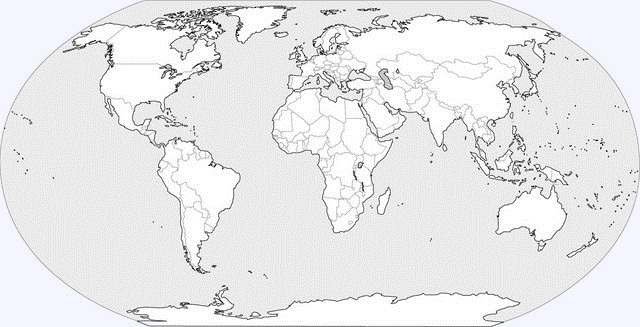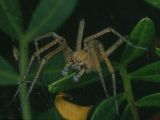|
Nombre común en ingles:
Baboon Spiders /
Tarantulas
Nombre común en castellano:
Se desconoce
Familias similares:
Género tipo:
Theraphosa Thorell, 1870
Diagnosis:
Medium-sized to very large mygalomorph spiders; two
or rarely three tarsal claws; eight eyes; four spinnerets; rastellum
absent; well developed scopulae and iridescent claw tufts on legs
tarsi and female palpal tarsi; tarsi with clavate trichobothria
along their length; labium and endites with numerous cuspules;
anterior lobeo n endite developed; distal segment of posterior
spinnerets digitiform.
Caracteres descriptivos:
Caparazón:
clypeus absent or wide:; fovea short, varies from straight to
procurved or recurved or provided with a distinct born-like process
or depression in Ceratogyrus; hirsute. Esternón:
with moderately small, oval, marginal to subcentral posterior
sigilla. Ojos: eight; in two rows forming small rectangular
group; eye tubercle present. Quelíceros: outer face or
chelicerae hirsute, or with dense scopulae in Ornithoctoninae and
Harpactirinae (except Harpactirella and Brachionopus) or
stridulating organs (Ornithoctoninae, Selenocosmiinae); inner face
with peg setae; rastellum absent or lateral (Euphrictus). Piezas bucales:
anterior lobe of endites developed into conical process; labium and
endites with numerous cuspules, rarely none on labium; serrula
absent or rarely present. Patas: hirsute; tarsi with two or
rarely three claws, scopulae and tufts; spination on legs III-IV
reduced in arboricolous species, dense in ground species, except
Selenocosminae; paired tarsal claws most often with only one row of
teeth, but claws with two rows and bare claws occur; clavate
trichobothria along lengh of coxa I maxillae (Selenecosminae) or
coxa II (Eumenphorinae) with long paddle-shaped setae as part of
stridulation organ; femur IV sometimes with scopula on retrolateral
face (Theraphosinae); tarsi as broad or broader than metatarsi
(Aviculariinae). Abdomen: oval; hirsute; with urticating
hairs in Theraphosinae and Aviculariinae. Hileras:
four; apical segment of posterior spinnerets long and digitiform. Sistema respiratorio:
four booklungs or book lungs, as elsewhere. Genitalia:
spermathecae paired and simple, unbranched at distal end; male palp
with a small second haematodocha and coniform distal sclerite;
subtegulum sometimes wide (Theraphosinae); embolus broad and
acuminate or long and thin. Tamaño corporal:
13-90 mm. Color: various hues of brown, blue, orange, yellow
and from pale grey to black; abdomen with variegated pattern.
Estatus taxonómico:
Theraphosidae is considered the sister-group of Paratropididae with
which it forms the Theraphosoidea, itself the sister of Barychelidae
and together forming the Theraphosoidina (Raven, 1985; Goloboff,
1995), Raven (1985) provided keys to the subfamilies and genera and
Smith (1990, 1995) to species of Africa and America.
Distribución: Pantropical
distribution. Subfamilies endemic as follows; Aviculariinae,
Theraphosinae (South America): Eumenophorinae, Harpactirinae,
Selenogyrinae, Stromatopelminae (Africa); Ischnocolinae,
Ornithoctoninae (India and Oriental); Thrigmopocinae (Oriental
Region).

Estilo de vida:
Free-living spiders inhabiting terrestrial, silk-lined burrows,
arboreal retreats or retreats made under rocks or in holes under
bark or under epiphytes.
Bibliografía:
-
Dippenaar-Schoeman, A.S. & Jocqué,
R. 1997. African Spiders: An Identification Manual. Plant Protection
Res. Inst. Handbook, no. 9, Pretoria, 392 pp.
-
Dippenaar-Shoeman,
A.S. 2002. Baboon and trapdoor spiders of southern Africa: An
identificacion manual. Plant Protection Res. Inst. Handbook, no. 13,
Agricultural Research Council, Pretoria, 128 pp.
-
Gallon, R.C. 2003. A
new African arboreal genus and species of theraphosid spider (Araneae,
Theraphosidae, Stromatopelminae) which lacks spermathecae. Bull. Br.
arachnol. Soc. 12: 405-411.
-
Goloboff, P.A. 1995.
A revision of the South American spiders of the family Nemesiidae (Araneae,
Mygalomorphae). Part I: species from Peru, Chile, Argentina, and
Uruguay. Bull. Am. Mus. nat. Hist. 224: 1-189.
-
Prentice, T.R. 2005.
Theraphosidae, pp.54-55 in Ubick, D., Paquin, P., Cushing, P.E. &
Roth, V. (Eds) 2005. The Spiders of North America. An Identification
Manual. American Arachnological Society.
-
Raven, R.J. 1985.
The spider infraorder Mygalomorphae (Araneae): Cladistics and
systematics. Bull. Am. Mus. Nat. 182: 1-180.
-
Raven, R.J. &
Schwendinger, P.J. 1995. Three new mygalomorph spider genera from
Thailand and China (Araneae). Mem. Qd Mus. 38:623-641.
-
Smith, A.M. 1990.
Baboon spiders: Tarantulas of Africa and the Middle East.
Fitzgerald Publ., London. 142 pp.
-
Smith, A.M. 1995.
Tarantula Spiders: Tarantulas of the U.S.A and Mexico. Fitzgerald
Publ., London, 196 pp.
1 género y 1 especie presentes en la Península Ibérica:
|
| |
- I. valentinus
(Dufour, 1820) |
| |
|
 |